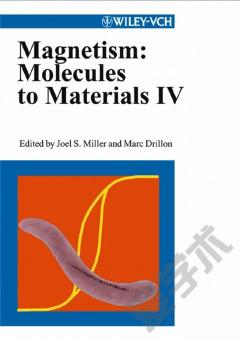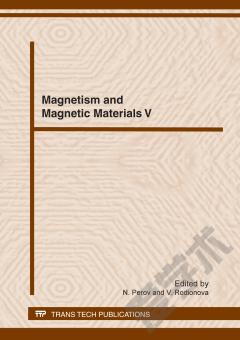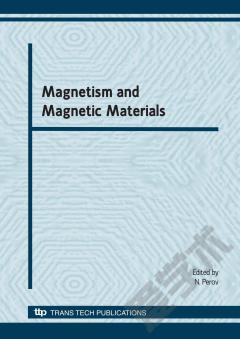Magnetism —— Molecules to Materials IV
----- 磁性
Preface. 1 Metallocenium Salts of Radical Anion Bis(Dichalcogenate) Metalates (Vasco Gama and Maria Teresa Duarte). 1.1 Introduction. 1.2 Basic Structural Motifs. 1.3 Solid-state Structures and Magnetic Behavior. 1.4 Summary and Conclusions. References. 2 Chiral Molecule-Based Magnets (Katsuya Inoue, Shin-ichi Ohkoshi, and Hiroyuki Imai). 2.1 Introduction. 2.2 Physical and Optical Properties of Chiral or Noncentrosymmetric Magnetic Materials. 2.3 Nitroxide-manganese Based Chiral Magnets. 2.4 Two- and Three-dimensional Cyanide Bridged Chiral Magnets. 2.5 SHG-active Prussian Blue Magnetic Films. 2.6 Conclusion. References. 3 Cooperative Magnetic Behavior in Metal-Dicyanamide Complexes (Jamie L. Manson). 3.1 Introduction. 3.2 "Binary" alpha-M(dca)2 Magnets. 3.3 beta-M(dca)2 Magnets. 3.4 Mixed-anion M(dca)(tcm). 3.5 Polymeric 2D (cat)M(dca)34As, Fe(bipy)3. 3.6 Heteroleptic M(dca)2L Magnets. 3.7 Dicyanophosphide: A Phosphorus-containing Analog of Dicyanamide. 3.8 Conclusions and Future Prospects. References. 4 Molecular Materials Combining Magnetic and Conducting Properties (Peter Day and Eugenio Coronado). 4.1 Introduction. 4.2 Interest of Conducting Molecular-based Magnets. 4.3 Magnetic Ions in Molecular Charge Transfer Salts. 4.4 Conclusions. References. 5 Lanthanide Ions in Molecular Exchange Coupled Systems (Jean-Pascal Sutter and Myrtil L. Kahn). 5.1 Introduction. 5.2 Molecular Compounds Involving Gd(III). 5.3 Superexchange Mediated by Ln(III) Ions. 5.4 Exchange Coupled Compounds Involving Ln(III) Ions with a First-order Orbital Momentum. 5.5 Concluding Remarks. References. 6 Monte Carlo Simulation: A Tool to Analyse Magnetic Properties (Joan Cano and Yves Journaux). 6.1 Introduction. 6.2 Monte Carlo Method. 6.3 Regular Infinite Networks. 6.4 Alternating Chains. 6.5 Finite Systems. 6.6 Exact Laws versus MC Simulations. 6.7 Some Complex Examples. 6.8 Conclusions and Future Prospects. References. 7 Metallocene-based Magnets (Gordon T. Yee and Joel S. Miller). 7.1 Introduction. 7.2 Electrochemical and Magnetic Properties of Neutral Decamethylmetallocenes and Decamethylmetallocenium Cations Paired with Diamagnetic Anions. 7.3 Preparation of Magnetic Electron Transfer Salts. 7.4 Crystal Structures of Magnetic ET Salts. 7.5 Tetracyanoethylene Salts (Scheme 7.2). 7.6 Dimethyl Dicyanofumarate and Diethyl Dicyanofumarate Salts. 7.7 2,3-Dichloro-5,6-dicyanoquinone Salts and Related Compounds. 7.8 2,3-Dicyano-1,4-naphthoquinone Salts. 7.9 7,7,8,8-Tetracyano-p-quinodimethane Salts. 7.10 2,5-Dimethyl-N,N'-dicyanoquinodiimine Salts. 7.11 1,4,9,10-Anthracenetetrone Salts. 7.12 Cyano and Perfluoromethyl Ethylenedithiolato Metalate Salts. 7.13 Benzenedithiolates and Ethylenedithiolates. 7.14 Additional Dithiolate Examples. 7.15 Bis(trifluoromethyl)ethylenediselenato Nickelate Salts. 7.16 Other Acceptors that Support Ferromagnetic Coupling, but not Long-range Order above ~2K. 7.17 Other Metallocenes and Related Species as Donors. 7.18 Muon Spin Relaxation Spectroscopy. 7.19 Mossbauer Spectroscopy. 7.20 Spin Density Distribution from Calculations and Neutron Diffraction Data. 7.21 Dimensionality of the Magnetic System and Additional Evidence for a Phase Transition. 7.22 The Controversy Around the Mechanism of Magnetic Coupling in ET Salts. 7.23 Trends. 7.24 Research Opportunities. References. 8 Magnetic Nanoporous Molecular Materials (Daniel Maspoch, Daniel Ruiz-Molina, and Jaume Veciana). 8.1 Introduction. 8.2 Inorganic and Molecular Hybrid Magnetic Nanoporous Materials. 8.3 Magnetic Nanoporous Coordination Polymers. 8.4 Summary and Perspectives. References. 9 Magnetic Prussian Blue Analogs (Michel Verdaguer and Gregory S. Girolami). 9.1 Introduction. 9.2 Prussian Blue Analogs (PBA), Brief History, Synthesis and Structure. 9.3 Magnetic Prussian Blues (MPB). 9.4 High TC Prussian Blues (the Experimental Race to High Curie Temperatures). 9.5 Prospects and New Trends. 9.6 Conclusion: a 300 Years Old "Inorganic Evergreen". References. 10 Scaling Theory Applied to Low Dimensional Magnetic Systems (Jean Souletie, Pierre Rabu, and Marc Drillon). 10.1 Introduction. 10.2 Non-critical-scaling: the Other Solutions of the Scaling Model. 10.3 Universality Classes and Lower Critical Dimensionality. 10.4 Phase Transition in Layered Compounds. 10.5 Description of Ferromagnetic Heisenberg Chains. 10.6 Application to the Spin-1 Haldane Chain. 10.7 Conclusion. References. Index.
{{comment.content}}








 京公网安备 11010802027623号
京公网安备 11010802027623号